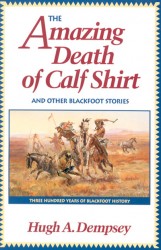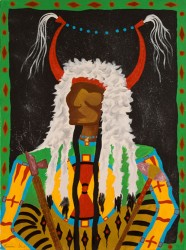Article Origin
Volume
Issue
Year
Onistah-Sokaksin, Calf Shirt, was the leader of the Nitayxkax, Lone Fighters Band, and was a great war chief of the Bloods, a Plains tribe in what is now southern Alberta.
Calf Shirt distinguished himself as a brave warrior numerous times in his life, but it was his curious death that makes him live on in history.
Born in about 1815 to a man named Cracked Ear, Calf Shirt grew to be a man of over six feet in height and weighed more than 200 pounds. He is said to have been handsome and likeable unless he’d been drinking.
His relative, Iron Collar, had been the original leader of the Lone Fighters, but by 1885 Calf Shirt had taken over and was recognized as one of the Blood tribe’s six leaders.
In that year, Calf Shirt was at the Judith River site where the United States government negotiated a treaty with the Blackfoot Nation and other tribes in the area. The treaty was established to bring peace to the warring Blackfeet and their enemies, including the Flatheads, Pend O’reilles, Kutenais, and Nez Percés.
The treaty also guaranteed an exclusive hunting ground for the Blackfeet, allowed for the peaceful entry of missionaries into the area and the building of military posts, and provided for an annual annuity of $20,000 for 10 years.
Calf Shirt may have signed the treaty but he was not ready to accept peace. He was a brave, reckless and ruthless warrior and rose to prominence partly because his people feared him.
While he was still a young man, he retreated from the Blood camp in the Sweetgrass Hills to seek power. He found a place at the top of East Butte, and while fasting there, a grizzly bear spirit appeared to him but refused to give Calf Shirt supernatural powers unless he presented the bear with a woman.
Returning to his camp, Calf Shirt told the youngest of his wives to put on her finest hide dress and accompany him to the butte. There, he stabbed her to death and piled a cairn of stones over her body before returning to camp to mourn her loss.
In a dream, the bear told Calf Shirt he had done well with his part of the bargain and he could expect to have protection: no bullet, knife or arrow could enter his flesh and he would be an invincible warrior.
After that, Calf Shirt entered many skirmishes and fights, always emerging the victor. In 1865, when two fellow chiefs were murdered by Americans, Calf Shirt led a war party which wiped out a number of pioneers who were establishing a town called Ophir, in Montana territory. After the raid, plans for building the town were abandoned.
In the late 1860s, with a huge camp of Bloods and Blackfoot under his leadership, Calf Shirt ordered an attack on a Cree camp. When the skirmish was over, the Blackfoot had killed more than 100 Cree. There had been only one casualty on their side – but it was Calf Shirt’s own son, Wild Insect Ear.
Before his people could feel sadness, the chief rode through the camp encouraging them to revel in how many of the enemy they had killed, and not to mourn his son.
By 1870, Calf Shirt had become a leading war chief of the tribe, with a personal following of 72 warriors and with 288 people in his Lone Fighters Band. Though he was a good leader, he had a terrible temper when he was drinking. He was so violent when he was under the influence that he was given the nickname Mini’ksee, Wild Person.
It was on a wintry day in December 1873 that Calf Shirt visited Fort Kipp. A few months earlier, the chief had left a shield with the proprietor Joseph Kipp as collateral for some goods he acquired on credit. Now he was joining a war party and needed his shield back. When Kipp demanded he pay for it, Calf Shirt admitted he had nothing to give in exchange.
Realizing the chief had a deadly temper, Kipp reached for his gun, hidden under a pile of blankets. Calf Shirt saw the movement and before the trader could grasp his weapon, drew his own gun and aimed it at Kipp.
Calf Shirt could have killed Kipp on the spot, but he walked out of the fort, and returned to his own camp. He fumed, planned his revenge, and then stripped to a breechcloth and moccasins. Calf Shirt painted his face and body with his sacred symbols, and sang his war song as he picked up his gun and headed back to the American fort.
Striding through the main gate, the chief must have thought his grizzly bear power would protect him. The Indian wife of one of the whiskey peddlers screamed that Calf Shirt was coming to kill them all and the fort’s residents assembled around the corner of one of the buildings. When they saw the menacing enemy, they didn’t hesitate to open fire. Together they pumped 16 bullets into Calf Shirt’s body and ended the life of one of the greatest war chiefs of the Bloods. Or so it was thought.
Calf Shirt’s body was stiff, due to the cold and the time that had passed, when his wives recovered his body. They took Calf Shirt inside a lodge and, knowing of his great powers, believed they could bring him back to life. The wives began the necessary rituals and even poured some of the whiskey he had liked so much down his throat. To everyone’s astonishment, Calf Shirt’s leg began to move. It seemed the women were succeeding in re-animating their husband and that he would return to lead them once again.
As the wives sang and prayed, someone suddenly mentioned how dangerous Calf Shirt had been at times in his life, and the others quickly agreed. The wives were restrained from completing their ceremony and Calf Shirt was left to continue his journey into the spirit world.
His band was amalgamated with the Awaposo-otas (Many Fat Horses) Band, under the leadership of a wealthy and respected war chief named Aka-kitsipimi-otas (Many Spotted Horses) and thrived for many years after.
- 4577 views


